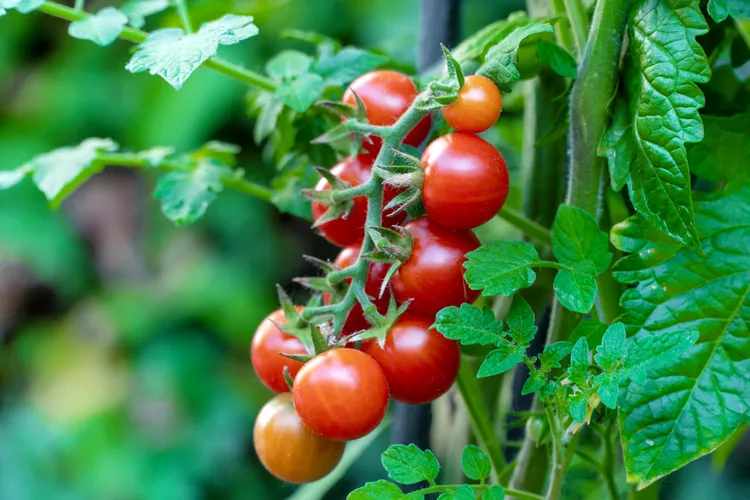Cherry tomato plants are the first type of tomato to ripen in summer gardens and one of the last that are still producing when frost threatens. The bite-size fruit is easy to enjoy fresh right off the prolific plants, or use your cherry tomatoes in a flavorful recipe. These growing tips will help you keep your plants healthy and maximize your harvest.
1. Pick award-winning hybrids.
Available in both round and oblong varieties (sometimes called grape tomatoes), cherry tomato plants fruit in a rainbow of colors. From rich red ‘Valentine’ to nearly orange ‘Sungold’ and the dusty plum of ‘Purple Bumble Bee,’ cherry tomatoes add instant color to a plate. A few varieties have received awards for their flavor, disease-resistance, ease of growing, and productivity. These cultivars are All-America Selections winners because of their superior performance from midsummer until frost.
- ‘Crokini’ has very sweet round fruit with a firm texture. Excellent disease resistance makes it a great cultivar for the Southeast.
- ‘Jolly’ produces clusters of a dozen or more round, red fruit. Disease resistany and productive, plants fruit until killed by frost.
- ‘Purple Zebra’ is a green and deep mahogany striped tomato with a complex flavor and firm texture.
- ‘Valentine’ has oblong fruit that is deep red and has a sweet taste. The meaty tomatoes resist splitting and hold well on the vine.
2. Try flavorful heirloom varieties.
Heirloom cherry tomato varieties are prized for their flavor and thin skins. They have a short window of harvest before they are overripe. Check the fruit daily when it begins to color. Heirloom cherry tomatoes have a shorter shelf-life than hybrids, but their flavor overrides their shortcomings.
- ‘Ingleheart Yellow’ has a sweet, rich flavor and a round shape.
- ‘Principe Borghese’ is a plum-shape Italian tomato with intense red coloring.
- ‘Yellow Pear’ has super sweet pear-shape yellow-gold fruit.
3. Give cherry tomatoes enough space.
Most cherry tomato plants are so productive because they are massive plants. Don’t be fooled by the size of the seedling at planting time. The 6-inch-tall garden center transplant will grow into a 6-foot tall and wide plant with sprawling branches in about two months. Give the plant plenty of space to grow to its full size by planting it so it has at least 3 feet of space on all sides.
4. Use a tomato cage.
A tall, sturdy tomato cage or trellis is essential for growing cherry tomato plants that will fruit until the first frost. Heavy-duty premade tomato cages can work if they are firmly anchored to the ground—the larger the cage, the more apt it is to topple over in a windstorm. Secure a tomato cage by sinking 6-foot-tall stakes 2 feet into the soil on either side of the tomato cage. Tie the cage to the stakes. You can also make your own tomato trellis using heavy gauge wire cattle panels and fence posts.
5. Choose short varieties for containers.
While tall trellises and generous spacing are a must for many cherry tomato varieties, it's still possible to grow this type of tomato in pots. That's because plant breeders have selected several cultivars that thrive in the confines of a large container. Plant these varieties in a container that is at least 14 inches wide.
- ‘Patio Choice Yellow’ produces yellow cherry-size tomatoes on 18-inch plants.
- ‘Tidy Treats’ produces tiny cherry-size tomatoes from midsummer until frost.
- ‘Tiny Tim’ is covered with flavorful red cherry-size fruit. It grows just 12 inches tall.
- ‘Tumbler’ has sweet, cherry-size tomatoes on cascading branches. Good cultivar for growing over the side of a container or in a hanging basket.
6. Plant early in warm regions.
If you garden in the extreme heat and humidity of Hardiness Zones 8 or 9 and have had trouble growing tomatoes in the past, plant cherry types in early spring. Because they ripen earlier than larger slicers and beefsteaks, cherry tomatoes often thrive in hot regions. Plant transplants in early spring so they can bloom and set fruit before temperatures rise above 85°F. Expect to harvest tomatoes before the intense summer heat sets in. ‘Super Sweet 100,’ ‘Sweet Treats,’ and ‘Juliet’ have good disease resistance for hot, humid climates.
7. Water regularly.
Cherry tomato plants need about an inch of water a week to grow and produce fruit. When natural rainfall doesn’t provide an inch of moisture, supplement with hand watering or drip irrigation. Regular watering is essential to fruit formation. Cherry tomatoes’ thin skins and petite fruit size makes them especially vulnerable to cracking or splitting. Dry conditions followed by abundant water will cause the tomato flesh to expand faster than the tomato skin and soon cracks develop so try to keep soil moisture consistent.
8. Harvest every couple of days.
Cherry tomato plants are so prolific that their fruit ripens almost constantly for weeks. Check plants every other day to harvest the ripe fruit. Cherry tomatoes are ripe when they are fully colored but still slightly firm to the touch. Harvest fruit regularly to spur plants to continue producing and keep pests at bay. Going away on vacation? Invite a neighbor to come harvest in return for watering.




















